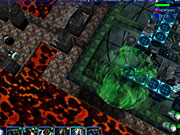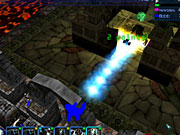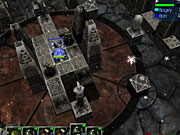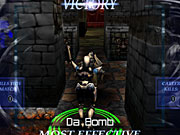Strategy First's real-time strategy game Nexagon: Deathmatch combines a number of different gameplay types--tactical combat, base building, and money management--and the result is a fairly unique game. Unfortunately, sluggish controls, missing features in the interface, and a nonexistent online community detract from an otherwise decent strategy game.
The premise of Nexagon: Deathmatch is similar to that of the 1987 Arnold Schwarzenegger film The Running Man. The citizens of the future have grown increasingly bored and restless, so a new form of entertainment has been created to placate them--televised gladiator combat. Criminals from around the universe are recruited to fight in elaborately designed deathmatch pits to amuse the crowds who watch them on television.

Graphics are not Nexagon's strong suit. The architecture is blocky, the textures are blurry, and the environmental effects like lava and explosions look rather primitive. At least the unit models are unique enough that you can differentiate them from one another, and the art styles of the various hordes in the game do reflect their themes. Nexagon's sound is a bit better, since it includes an upbeat rock soundtrack and an amusing play-by-play announcer whose quips may remind you of the hyperactive announcer from the classic arcade game Smash TV.
You can choose from one of four different horde types: the fantasy-themed Tekhan, the industrial Strunar, the futuristic Ghandros, and the organic-alien-like Olfrum. The units in Nexagon are known generically as thralls, and they come in four types: moles, drones, golems, and brains. Moles are basic soldiers with the ability to man the neutral weapon emplacements strewn around the pits. They are also the only class that can get special items like med kits and bombs out of the dispenser units. The drones generally excel at close-quarters combat and have the ability to climb short obstacles without the benefit of ramps. Golems are slow-moving power units that can inflict great damage and have plenty of hit points, while the brains are support units with special spells and abilities that enhance their teammates or adversely affect enemies.

Each of the four hordes has unique abilities and attributes. For example, the Strunar drone is the only drone with a ranged attack, as it carries a shotgun. However, it moves much more slowly than the other hordes' drones and is the worst at hand-to-hand combat. The Olfrum golem regenerates hit points on its own and explodes in a cloud of poisonous gas when it is knocked out in combat. The variation in abilities between the different thralls gives each horde its own unique playing style.
Before entering battle on each map, you'll build your base, or sanctum, with the goal of protecting the delicate nexus, which serves as the core of your sanctum. The nexus is where your troops respawn after being knocked out in combat. Using the game's base-building editor tool, you'll set up various barriers and traps to make it difficult for enemies to infiltrate. You'll also place decorations, which don't serve any tactical purpose in battle, but help with your horde's crowd appeal, which affects the amount of money you receive after each match. What's annoying is that the editor doesn't let you pick up and move existing pieces of your sanctum. If you want to free up space, or alter a design, you must sell off old building blocks at a loss and buy new ones.
Once you're done setting up the sanctum, you will manage your horde's bench by buying and selling thralls. As your thralls gain experience in combat, they'll improve steadily in marksmanship, hand-to-hand combat, and defense. However, the more they are knocked out in combat, the more likely it is that they will sustain wounds that will negatively affect their performance and make them more susceptible to death. You can have only six thralls in the pit at once, so over the course of the campaign, it helps to keep extra thralls around on your bench and allow wounded veterans to sit out matches and heal.

Matches are played in three separate periods, like a hockey game. All thralls return to their respective sanctums during intermissions and heal, so the stoppages help the side that was losing by giving it a fresh start. You can earn points by knocking out enemy thralls or capturing and controlling special billboards in the neutral zone of each pit. Since a billboard constantly generates points for your team over time, controlling the billboards in a pit is often the most important aspect of a match, although it is also possible to win the match outright by destroying the enemy nexus. Fortunately, all the block elements in a pit are completely destructible, so you can change your strategy on the fly. If you find it hard to control a certain billboard, you can send a strike force to destroy it. If a certain choke point is giving you problems, you can always create your own path by blowing a hole in another wall.
Nexagon's biggest failing is that its control scheme is extremely sluggish. Thralls are not intelligent enough to find their way through narrow spaces if there's a group of them trying to get through. Once they run into an obstacle, they often become confused and forget the last order you issued. This requires you to play Nexagon a lot differently than you'd play most other real-time strategy games. Instead of group-selecting your units to attack a nearby enemy, you often have to micromanage your thralls individually. Keeping your ranged units in the right position is exceedingly important, as you'll often find them shooting their melee teammates in the back if you're careless. If you have a thrall with explosive splash damage, such as the Strunar golem, friendly fire can be catastrophic. Thankfully, the game includes a pause function that lets you issue orders while the game is stopped, though you can pause the game only for a limited time.

It's also frustrating that the game does not let you view the design of a new pit before going into battle. Considering that the layout of a particular pit will greatly affect your decisions when fielding a team and redesigning your nexus, this oversight is especially irksome. The intermissions in between periods allow you to make adjustments to your team on the fly, but a poorly chosen starting squad will still leave you at a significant disadvantage for the rest of the match.
Unfortunately, we weren't able to get much out of the game's multiplayer modes. Like with other real-time strategy games that aren't as high profile as Warcraft III or Age of Mythology, it's tough to find multiplayer games of Nexagon. In fact, as of this review, we could find absolutely no hosted games at all using the in-game server browser on many different occasions at different times of day. We tried playing the game over a LAN--the game's implementation of network play seems pretty rough. There is no pre-game chat room for players to haggle over game settings and rules or even for you to exchange pleasantries before being thrust into a match. Each player is still allowed to pause the game to issue orders using the game's limited pause meter, but in practice it seems somewhat awkward for the game to start and stop abruptly at either player's whim.
If you can overlook the frustrating controls and a few missing features, you'll find that Nexagon: Deathmatch is actually a decent strategy game that offers a fairly distinctive gameplay experience. Despite the difficulty you'll likely have in finding online opponents, the game does offer a good variety of pits, as well as four uniquely designed playable sides.